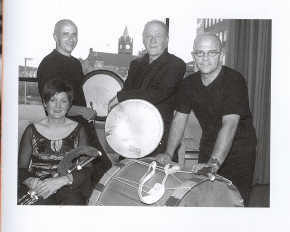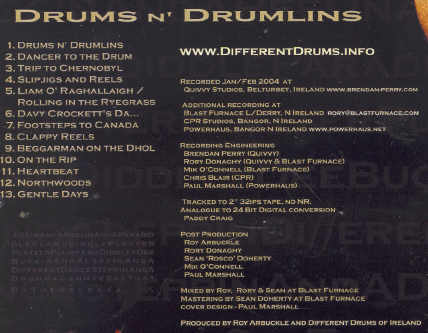|
Different Drums of Ireland Rhythm Sticks 10
Purcell Room, London, 24 July 2004
 It was good to hear live these Ulster musicians making their first visit to London during the SBC Rhythm Sticks season. It was good to hear live these Ulster musicians making their first visit to London during the SBC Rhythm Sticks season.
There was a vast array of instruments on stage, introduced in a subtle sequence to hold interest. The scheme was to bring together the indigenous
Bodhrán and Lambeg with the African Djembe and Middle Eastern Darbuka; the player of the latter had too a contemporary drum kit, and it has to be said that this sometimes undermined the Irish traditional instruments.
We own a bodhrán and have made unavailing efforts to master it; three of these versatile musicians play different sizes with unflappable ease and never failing energy. The melodist in the group, Dolores, is adept on whistles and elbow pipes, and the lead presenter accompanied his singing on guitar. A little hard to tell which is Paul, Roy or Stephen? They are all shaven (one of them still has a pony-tail); there was no printed programme and the announcements through the microphone, in rich Irish brogue, were mostly unintelligible as they came across to us.
The large Lambeg is a fearsome monster, producing as many decibels as a small aircraft taking off, we were proudly told! Luckily planes don't take off inside the Purcell Room, which is small and intimate, rendering electronics (which audiences nowadays seem to expect) unnecessary.
Amplification was however restrained to a reasonable 'enhancement' level in the better first half, but after the interval seemed to drift louder (a frequent experience in Asian and "world music" concerts).
The second half was altogether less interesting and the promised Long Drum never appeared.  There is far greater clarity on Different Drums CDs, in which you can hear every word of the interesting songs (listen to samples on line). There is far greater clarity on Different Drums CDs, in which you can hear every word of the interesting songs (listen to samples on line).
Their most recent CD Drums n' Drumlins has the same line-up we heard and is recommendable; without the incongruities of the mixture visibly distracting, it makes for very cheerful listening. The credits make clear that these musicians are technologically expert; they need to be more rigorous with their live electronics in concert.
Peter Grahame Woolf
About Different Drums of Ireland
"If we do not learn to create an authentic sense of community at the local level, how are we going to stop wars between nations?" asks Roy Arbuckle, the Director and Founder of the unique Irish music group, Different Drums of Ireland. Founded in 1992, the group were initially inspired by the Kodo drummers of Japan and have created an entirely new programme which has its roots in the Northern Irish tradition but flowers in the emerging 'World Music' scene. - - Different Drums play a range of unique music which draws from the Irish, Scots-Irish and African traditions. The music also features the Uilleann or elbow pipes, whistles, guitar and vocals and is driven by the engine of the African Djembe. Adding percussion and other instruments to original and traditional songs creates an exciting combination of traditions and sounds. - -
COMMENTS FROM ANOTHER DRUMMER
I was expecting Drums of Ireland to be just that. I must confess to feeling a little cheated. I do not have a problem with a mix of instruments from different cultures in order to create interesting musical fusions. However it's not enough to simply bolt on the rhythms and playing styles of one type of music onto another and expect this to be an enhancement to both. The djembe in particular is not Irish neither is the Scottish type pipe band snare drum.The kick drum also comes from a different musical discipline. Irish music has an inherent bounce chiefly because of the ornamental style of playing. The bodhran can support and drive the music along, following the tune from within so to speak whereas, to my ears, the strident nature and volume levels of djembe,and kit and congas etc., sound as if they are 'sitting' on top of the music and, contrary to the intentions of the players, make the music sound somewhat square and solid, thereby destroying the 'feel' and vitality they might have thought they were creating. Modern bodhran playing now uses a great many different and varied tones and I happen to know that the players on Saturday night are well respected for their ability in this area.
So it was disappointing that these subtleties were lost in a deep rumble because of the way the bodhrans were miked up and equalised, and drowned out altogether when the djembe and snare drum were added - the bodhrans might as well have stopped playing. I was interested to hear more about the Lambeg drum and would have liked a verbal introduction about its use in the music of Ireland. Its impressive roar when used towards the end of the tunes was arresting if not musically satisfying, but at least it drowned out the djembe's tedious 'motor rhythms'.
During this percussion festival, themed around drums from different countries, there was ample opportunity to hear and enjoy drums played well in the styles to which they are suited. I think therefore it was a mistake to offer this attempt at blending, which only resulted in diluting the characteristics of the various instruments. Of course every band has the right to choose its instrumentation and style, and 'tough' if certain members of the audience don't like it. However, in the context of proclaiming the special qualities of Irish Drums and drumming, this presentation didn't work this time.
|



